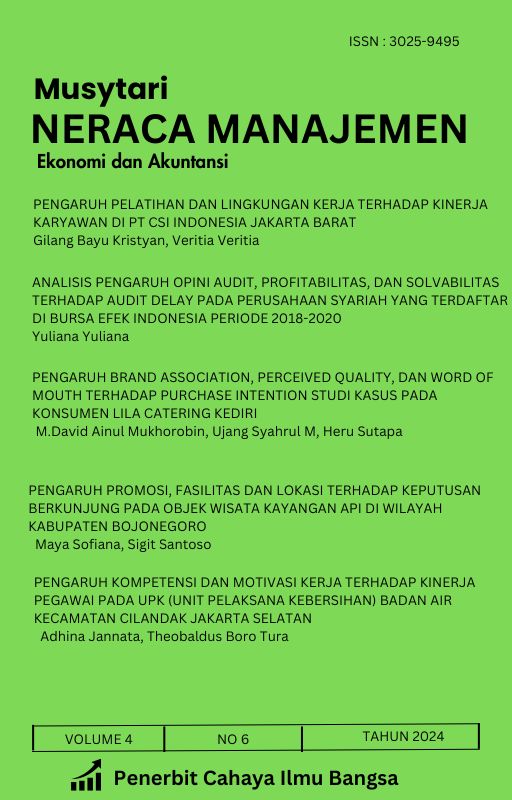Pengaruh Profitabilitas, Leverage dan Intensitas Aset Tetap terhadap Tax Avoidance Perusahaan Syariah yang Terdaftar di Jakarta Islamic Index (JII)
Main Article Content
Abstract
This study aims to examine the effect of profitability, leverage, and fixed asset intensity on tax avoidance practices among Sharia-based companies listed on the Jakarta Islamic Index (JII) during the 2021-2024 period. Tax avoidance is a legal strategy used to reduce tax burdens by exploiting loopholes in tax regulations. However, such practices raise ethical concerns, especially for Sharia-compliant companies that are expected to uphold the values of transparency and justice. This research employs a quantitative approach using panel data regression analysis with E-Views software on four companies selected through purposive sampling. The results reveal that none of the three independent variables profitability, leverage, and fixed asset intensity significantly affect tax avoidance, as measured by the Effective Tax Rate (ETR). These findings suggest that financial indicators alone are insufficient to explain tax avoidance behavior in Sharia-based firms. Ethical considerations and adherence to Sharia principles also play a significant role. The implications highlight the need for strengthening transparency and accountability in the governance of Sharia-compliant firms, along with stricter fiscal oversight to maintain public trust
Downloads
Article Details
Section

This work is licensed under a Creative Commons Attribution-NonCommercial-ShareAlike 4.0 International License.
How to Cite
References
Awaliah, R., Damayanti, R. A., & Usman, A. (2022). Tren Penghindaran Pajak Perusahaan di Indonesia yang Terdaftar di BEI Melalui Analisis Effective Tax Rate (ETR) Perusahaan. Akrual: Jurnal Bisnis dan Akuntansi Kontemporer, 15(1), 1-11.
Azwar, M. C. A., & Fitrijanti, T. (2024). Pengaruh Intensitas Aset Tetap, Profitabilitas, dan Kepemilikan Institusional terhadap Penghindaran Pajak pada Perusahaan Sektor Property dan Real Estate. Jurnal Penelitian Inovatif (JUPIN), 4(3), 1539-1556.
Barella, Y., Fergina, A., Mustami, M. K., Rahman, U., & Alajail, H. M. A. (2024). Quantitative Methods in Scientific Research. Jurnal Pendidikan Sosiologi dan Humaniora, 15(1), 281-287.
Desai, M. A., Foley, C. F., & Hines Jr, J. R. (2007). Dividend policy inside the multinational firm. Journal of Financial Economics, 93(1), 73–94.
Devi, Y., Saefurrohman, G. U., Rosilawati, W., Utamie, Z. R., & Nurhayati, N. (2022). Analisis Penyebab Penghindaran Pajak (Tax Avoidance) Dalam Laporan Keuangan Pada Perusahaan Yang Terdaftar di BEI Tahun 2016-2019. Jurnal Akuntansi Dan Pajak, 22(2), 622–627.
Fadhila, N., & Andayani, S. (2022). Pengaruh Financial Distress, Profitabilitas, dan Leverage terhadap Tax Avoidance. Owner: Riset & Jurnal Akuntansi, 6(4), 3489-3500.
Hanlon, M., & Heitzman, S. (2010). A review of tax research. Journal of Accounting and Economics, 50(2–3), 127–178.
Kusumaningrum, D. P., & Iswara, U. S. . (2022). Pengaruh Profitabilitas, Leverage, dan Ukuran Perusahaan terhadap Nilai Perusahaan. Jurnal Ilmiah Akuntansi Dan Keuangan (JIAKu), 1(3), 295–312.
Madany, N., Ruliana, & Rais, Z. (2022). Regresi Data Panel dan Aplikasinya dalam Kinerja Keuangan terhadap Pertumbuhan Laba Perusahaan Idx Lq45 Bursa Efek Indonesia. VARIANSI: Journal of Statistics and Its Application on Teaching and Research, 4(2), 79-94.
Mobonggi, I. D., Achmad, N., Resmawan, & Hasan, I. K. (2022). Analisis Regresi Data Panel Dengan Pendekatan Common Effect Model Dan Fixed Effect Model pada Kasus Produksi Tanaman Jagung. INTERVAL: Jurnal Ilmiah Matematika, 2(2), 52-67.
Muid, G. P. D. (2022). Pengaruh Profitabilitas dan Leverage Terhadap Tax Avoidance. Diponegoro Journal of Accounting, 11(1), 1-6.
Nandita, D. A., Alamsyah, L. B., Jati, E. P., & Widodo, E. (2019). Regresi Data Panel untuk Mengetahui Faktor-Faktor yang Mempengaruhi PDRB di Provinsi DIY Tahun 2011-2015. Indonesian Journal of Applied Statistics, 2(1), 42-52.
Nopianti, R., Komarudin, M. F., & Triana, L. (2023). Pengaruh Leverage dan Likuiditas terhadap Nilai Perusahaan dengan Pemoderasi Umur Perusahaan. Owner: Riset & Jurnal Akuntansi, 7(3), 2566-2576.
Richardson, G., & Lanis, R. (2007). Determinants of the variability in corporate effective tax rates and tax reform: Evidence from Australia. Journal of Accounting and Public Policy, 26(6), 689–704.
Sariningsih, N., & Sastri, E. T. (2024). Pengaruh Intensitas Aset Tetap, Beban Pajak Tangguhan dan Pertumbuhan Penjualan terhadap Penghindaran Pajak. PJEb: Perwira Journal of Economy and Business, 4(1), 124–135.
Selviana, D. (2023). Pengaruh Leverage, Profitabilitas, dan Ukuran Perusahaan Terhadap Tax Avoidance. Jurnal Ilmu dan Riset Akuntansi, 12(3), 1-15.
Setianingrum, I. F. (2019). Pengaruh Profitabilitas, Leverage, dan Ukuran Perusahaan Terhadap Tax Avoidance Pada Industri Subsektor Pulp dan Kertas. Jurnal Ilmu dan Riset Akuntansi, 8(9), 1-18.
Sinaga, W. M., & Oktaviani, V. (2022). Analisis Faktor-Faktor Yang Mempengaruhi Tax Avoidance. Jurnal Riset Akuntansi dan Auditing, 9(1), 40-56.
Winantisan, R. N. N., Tulung, J. E., & Rumoko, L. J. (2024). Pengaruh Keberagaman Usia Dan Gender Pada Dewan Komisaris Dan Direksi Terhadap Kinerja Keuangan Perbankan Di Indonesia Periode 2018-2022. Jurnal EMBA, 12(1), 1-12.
